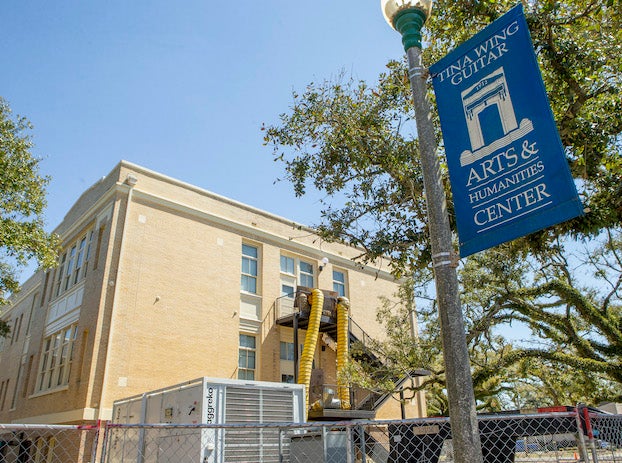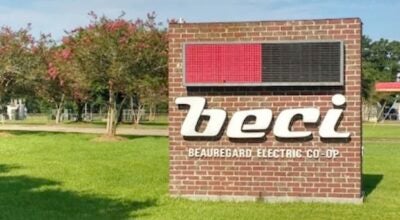Remediation even more complicated after asbestos discovery in Central School
Published 4:02 am Thursday, March 17, 2022

- Each of the 24 tenants that had leases at Central School before Hurricane Laura were forced to vacate the building so crews could identify the extent of repairs and address any remediation work. Those tenants and provided portable storage units that remain on the property. (Rick Hickman / American Press)
The historic Central School Arts and Humanities Center in downtown Lake Charles remains closed since Hurricane Laura’s Category 4 landfall in August 2020 left it severely damaged.
Hurricane Delta’s landfall nearly two months later brought water into the facility’s partially exposed roof, causing further damage. Today, belongings from tenants who had short- and long-term leases at Central School pre-Hurricane Laura are visible outside the building.
The city has contracted the Alexandria-based Ratcliff Construction Co. to do interior repairs at a cost of roughly $2.56 million. It is expected to take 180 working days and cover repairs to damaged walls, ceilings, wood trim and flooring; the installation of a new mechanical yard for a replaced air conditioning and heating system; electrical, plumbing and drainage repairs.
Those repairs remain on hold, however, while Ratcliff continues remediation work through the end of March or early April.
Lori Marinovich, city assistant director of planning and director of the Historic Preservation Commission, said remediation became more complicated after crews discovered asbestos in the plaster material of the walls and ceilings.
The city’s policy calls for a 10 percent change order limit on this construction project, which amounts to $256,000. The removal and disposal of hazardous material will cost another $535,119, requiring
City Council approval of a higher change order amount. The council voted 6-0 two weeks earlier to cap the change order amount at $750,000.
The council’s vote to cap the higher change order was unanimous. However, District A City Councilman Marshall Simien said he doesn’t want the repairs at Central School to become a money pit, especially if other costly problems are uncovered. Central School is located within District A.
“Any change order is disturbing,” he said. “You can’t give people a checkbook on a project. I wouldn’t do it with my own repairs — I definitely wouldn’t do it with public funds. With any investment you make, you have to get a reasonable return on it.”
Marinovich said Hurricane Laura severely damaged the multiple rooftop air conditioning units at Central School. Those units served individual rooms in the building. As part of the repair process, an alternative is in the works.
“We realized putting little HVAC units on the roof is not the best idea, so we decided to create HVAC yards on the ground,” she said.
“The old way was piecemeal climate control, with all of the small units having to crank up the air conditioner. Now, we will have more consistent climate control so we can preserve the integrity of the structure.”
Once the rooftop HVAC units were removed, Marsh Waterproofing Inc. replaced the roof at a cost of $592,575, Marinovich said. The City Council awarded the bid to the company in Feb. 2021. Marinovich said each of the 24 tenants that had leases at Central
School before Hurricane Laura were forced to vacate the building so crews could identify the extent of repairs and address any remediation work. She said the city coordinated with those tenants and provided portable storage units.
“It took a while to have them vacate the rooms, and all tenants were given a period of time to get their equipment and materials out,” she said. “Crews were then able to get in and do environmental testing, and while we were testing for moisture, that was when asbestos tests came back positive for the plaster material.”
Simien said he realizes the importance of Central School and its historic value to the community. However, other post-hurricane challenges still remain, with housing availability being one of the biggest.
“Our low-income housing still has blue roofs, and we’re having issues within the structures themselves,” he said. “We don’t have places to move people to make those repairs. Rents are so high, and the market rate of housing is going up. We still have people displaced who want to come home.”
Another of Simien’s concerns involves the hurricane-damaged city parks that are still closed.
“History has shown that it’s important to keep kids busy and off the streets, especially during the summer,” he said. “Otherwise, kids can get into a lot of things.”
Marinovich said Lake Charles’ cultural economy, including Central School, is unique and valuable. She said the vision is for a repaired Central School to act as more of an incubator for cultural activities.
“We have meeting rooms, a theater area, galleries, educational components and office space,” she said. “It’s a very needed aspect.”
Getting tenants to return to Central School once it’s repaired will be challenging, Marinovich said. She anticipates 2023 being a year of celebration for the newly-repaired facility.
“Perhaps there will be others who can come into those spaces to help give it a renaissance and new life,” she said. “I hope that when we’re closer to reopening, there will be more meetings and communication on how we can revision the structure and pull those tenants back and bring it back to what it can be.”
New Orleans architects Favrot & Livaudais designed and built Central School in 1912. The facility operated as a school until 1976, when it began to house School Board administrative offices. City voters in 1992 approved a half-cent sales tax to refurbish the facility and turn it into an arts and humanities center. It reopened as a local arts center in October 1997.





